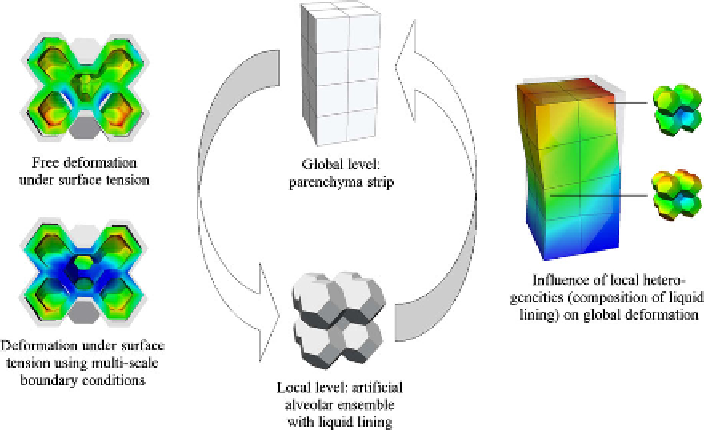Biomedical Engineering Reference
In-Depth Information
Fig. 28.2
Simple numerical example illustrating the mutual coupling of parenchyma and alveolar
levels in the multi-scale model.
Right
: heterogeneous deformation of simplified lung parenchyma
strip due to locally different alveolar liquid lining compositions.
Left
: deformation states for alve-
olar assemblages under surface tension load using traction-free (
top
) and multi-scale boundary
conditions (
bottom
)
facial effects are defined and associated with selected macro-scale Gauss integration
points. For the macro-micro scale transition, currently displacement boundary con-
ditions are utilized. Since the boundary deformation of each RVE is prescribed
according to the associated macro-scale deformation state, RVEs of neighboring
Gauss points influence each other indirectly via the macro-level. Hence, the impor-
tant interdependence effect is inherently considered in our model. After solution
of the local, constrained micro-problem, computational homogenization procedures
are employed to determine volume-averaged densities, stresses, and constitutive
tensors for the macroscopic simulation. A schematic representation of the dynamic
multi-scale method is shown in Fig.
28.1
.
Since global parenchyma and local alveolar models are simulated simultane-
ously, a mutual information transfer is enabled. The right hand side of Fig.
28.2
shows exemplarily the overall heterogeneous deformation of an idealized lung
parenchyma strip due to locally different compositions of the alveolar liquid lining.
A diseased state was modeled by assuming a deficiency of surface active agents, i.e.
a purely aqueous liquid lining, in some of the associated alveolar micro-structures.
This phenomenon is known to occur in case of lung failure. On the left hand side
of Fig.
28.2
, the effect of the multi-scale boundary conditions on local alveolar de-
formations is illustrated. For comparison, the behavior of an alveolar ensemble with
traction-free boundary conditions was simulated. This type of boundary condition
has been standardly employed in alveolar simulations so far. For a given surface
tension load on the interior surfaces, considerable differences in the resulting defor-

